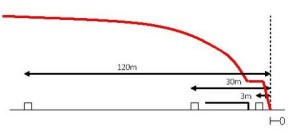A serious collision in Amsterdam on 21 May 2004 was the trigger for development of ATB Vv. The system in use at the time, known as ATB-EG (Automatische Trein Beïnvloeding Eerste Generatie, automatic train protection, first generation) could only stop a train that had passed a signal at danger if it was moving at more than 40 km/h.
ATB Vv (Automatische Trein Beïnvloeding Verbeterde versie – automatic train protection, enhanced version) is an extension of ATB-EG. The new system closes the ATB-EG “speed gap”.
The most important feature of ATB Vv is that rather than monitoring the speed of the train, it looks at whether the train will be able to stop before the next signal at danger, on the basis of its current speed and its braking characteristics. This system is called brake curve supervision.
The concept behind adding brake curve supervision to ATB-EG was developed by Movares, in cooperation with Lloyd’s Register Rail Europe. ATB Vv was developed for infrastructure manager ProRail and passenger services operator NS Reizigers, with Movares managing the technical aspects. The biggest challenge was to design a new system that would guarantee optimal integration with existing systems and could be installed on infrastructure and on both old and new rolling stock. That involved intensive cooperation with the customers and with Alstom, who made the modifications to the on-board equipment. This was a well thought-out concept, capable of being integrated into existing systems with minimal modification. In turn, this enabled rapid, economical implementation nationwide, and has led to a significant drop in the number of signals passed at danger.
The system consists of a control unit (the ASK – Aansluitkast, or connection box), which is connected to the signal and controls a number of beacons and/or loops on the track. The ASK also controls a unit built into the ATB-EG system on the train. That unit reads the signal aspect from the beacons/loops and applies the brakes if necessary.


